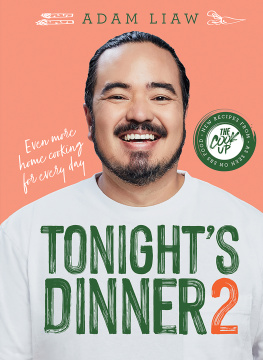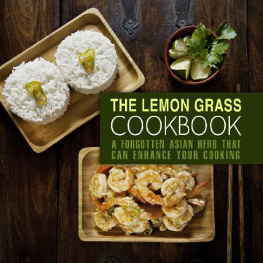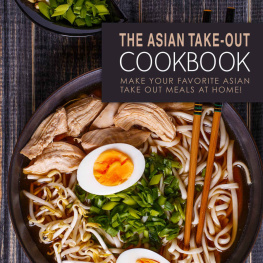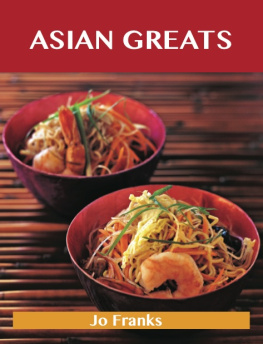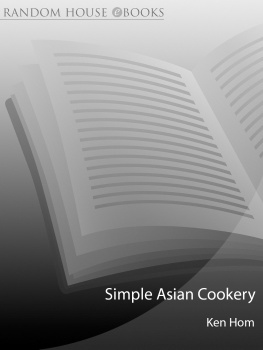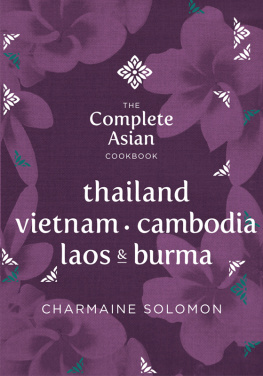Adam LiawsAsian CookerY School
Published in Australia and New Zealand in 2015by Hachette Australia(an imprint of Hachette Australia Pty Limited)Level 17, 207 Kent Street, Sydney NSW 2000www.hachette.com.au 10 9 8 7 6 5 4 3 2 1 Copyright Adam Liaw 2015 This book is copyright. Apart from any fair dealing for the purposes of private study, research, criticism or review permitted under the Copyright Act 1968, no part may be stored or reproduced by any process without prior written permission. Enquiries should be made to the publisher. National Library of AustraliaCataloguing-in-Publication data: Liaw, Adam, author. Adam Liaws Asian cookery school/Adam Liaw. 978 0 7336 3430 7 (hardback) 978 0 7336 3429 1 (ebook) Cooking, Asian 641.595 Jacket and internal design by Liz Seymour/Seymour DesignsPhotography by Steve BrownFood styling by Berni SmithiesFood preparation by Olivia AndrewsTypeset in 9.5/13 Interstate light by Seymour DesignsThis ebook edition was created using CircularFlo from CircularSoftware
For my Dad, who taught me everything I know
contents
LESSON 1A STARTING POINT Spinach in sesame dressing Mushibuta Steamed ginger chicken Pork belly, cabbage and shiitake hotpot Korean braised chilli chicken Steamed fish with ginger and spring onion Nyonya chicken stew LESSON 2UNDERSTANDING FLAVOUR SAUCES Sambal belacan Nuoc cham Patismansi Nam jim jaew Ponzu Chillies in soy sauce STOCKS Coarse stock Shiitake mushroom stock Bonito stock Anchovy stock Chicken stock Cabbage and soybean paste soup Miso soup with spinach and egg Pork sinigang Korean tofu stew Pad Thai LESSON 3UNDERSTANDING TEXTURE Mixed tempura Mixed sashimi Chicken and vegetable nimono Dressed cucumber Popcorn chicken with basil Pork, prawn and green papaya salad Chicken and coconut curry noodles Dragon and phoenix LESSON 4THE WOK Egg fried rice Stir-fried beansprouts with garlic Beef and basil Lemongrass beef Beef with broccoli and oyster sauce Beef chow fun Salt and pepper prawns Singapore chilli crab
preIV asian cookery school
LESSON 5RICE AND NOODLESRice Cucumber and tuna sushi rolls Boiled dumplings Cold udon noodles Salmon rice balls Bun cha Cold sesame noodles Vietnamese spring rolls Rice paper rolls Indonesian chicken fried rice LESSON 6VEGETABLES BANCHAN Beansprout soup Spinach namul Potatoes braised in soy sauce Stuffed cucumber kimchi Oiled greens Summer vegetables in light soy stock Simmered pumpkin Vegetable kakiage LESSON 7SEAFOOD Black pepper and caramel braised fish Fish ball noodle soup White fish teriyaki Marinated tuna rice bowl Miso-cured cod Salt-grilled salmon Sambal squid LESSON 8POULTRY Khmer Krom barbecue chicken Crackling chicken steak White cut chicken Crispy skin chicken Teochew braised duck Red pepper chicken Chicken, coconut and galangal soupIndonesian grilled chickenLESSON 9MEAT Beef satay Dongpo pork Lamb with ginger and spring onion Bistek Steamed spare ribs with black beans Thai grilled pork Braised minced pork Pork chop rice Glazed pork donburi LESSON 10SWEETS Green tea ice cream Red bean paste Sweet red bean soup Glutinous rice dumplings in ginger syrup Anmitsu Coconut and palm sugar jellies Coconut sticky rice with mango Sesame balls
Adam Liaw preV
Introduction I love Asian food.When I was a kid, my brother Aron and I would always order Crispy Skin Chicken at our local Chinese restaurant. Every time. We would argue over what spices we thought were in the five-spice salt, and fight over whether the thigh or wing was the best part of the bird (the thigh was always juicier, but the wing had more of the crispy skin). We would wonder how they got the skin so crispy, and my parents or grandma would chime in with a piece of sage advice now and then. After a hundred conversations over a hundred dinners I knew Crispy Skin Chicken inside and out long before I ever thought to make it myself. You can find my recipe now on page 175.I ate a thousand pieces of bad sushi (and loved them) before I had my first good piece and never looked back. Then I probably ate a thousand more pieces of good sushi before I picked up a sushi mat for the first time. If you want to give it a try, there are a couple of classic rolls on page 103. If you love to eat Asian food, knowing how to cook it is a natural and important progression. In this book I want to teach you all about Asian food not just how to cook it, but also how to understand it and appreciate it. Food does not exist on its own. It goes hand-in-hand with culture and experience, and to try and separate food from those things or to reduce it to just a list of ingredients and a method in a written recipe, would be to only tell half the story. As you follow the recipes in this book also follow the stories and context around them. Those are equally important. My education in food didnt just come from repeating recipes over and over (although that was certainly part of it). When I first learned to cook from my parents and grandparents they passed me their knowledge with a comment here, a guided hand there, and even a laugh or a sharp word when it was needed. I learned more from the hundreds of tips and
preVI asian cookery school
small wisdoms that my family and friends passed to me over the years than I ever could have learned from recipes alone. Those moments taught me how to think about food.I often hear people say that they dont need to learn how to cook Asian food because they just eat it at restaurants where its easy and affordable. Thats a reasonable sentiment, but one that I think misses the point.The food I love is personal and important to me, and I dont think I could ever completely hand over something so important to a stranger I will never meet, working out the back of a restaurant. Dont get me wrong; I love going out to eat, but I wouldnt consider it a substitute for the experience of home cooking. You can buy a hamburger for just a few dollars in just about every country in the world, but if you love hamburgers does that mean you should never learn how to make one? Asian food is cheap and readily available, and yet all through Asia people still cook it at home every single day.Home-cooked food is more than just a tasty meal. Its an experience, a process, an achievement, and an expression of who you are. I can order dumplings anywhere, but even the best dumplings from the best restaurant wont be the same as the Shui Jiao (page 106) my grandma taught me to make. The first time I cooked Chicken and Vegetable Nimono (page 58) with my wife, she told me a story of how her mother and late grandmother had shown her how to make it years before. I wouldnt give that experience up for anything.In this book Ive tried to show you more than just recipes. Ive tried to show you some of the insights into Asian cookery that my family and friends have given me throughout my life. Its through those insights that I learned to cook, and I offer them to you here in the hope that you might want to learn too.
introduction preVII
preVIII asian cookery school
Lesson 1 A Starting PointThere is no such thing as a single, unified Asian cuisine. Even if we only count the countries of East and Southeast Asia, we have nearly twenty separate nations, each with their own history, language, culture and cuisine. The breadth and variety in Asian cuisines is staggering, but even with their differences, centuries of trade, migration and shared history means we can draw some lines of consistency between them. Dishes originating in Indonesia have turned up in modern-day Okinawa, Chinese noodles are found all over the region, and even sushi an icon of Japanese cuisine can trace its origins back to Thailand. In the lessons in this book I havent tried to give you a definitive comparison of the styles of the many schools of regional Chinese cuisine, or to illustrate the differences between the food of the different provinces of Thailand. That level of detail is a story for another time. This book is an introduction to the techniques and flavours of Asian cookery, and Ive selected dishes from around the region to show you a broad and authentic impression of how people in Asia really eat. Not every dish may be to your taste, but certainly some will be. Think of this book as the start of your journey to discover Asian cookery. Right now, were just deciding which direction to walk in.
Next page


